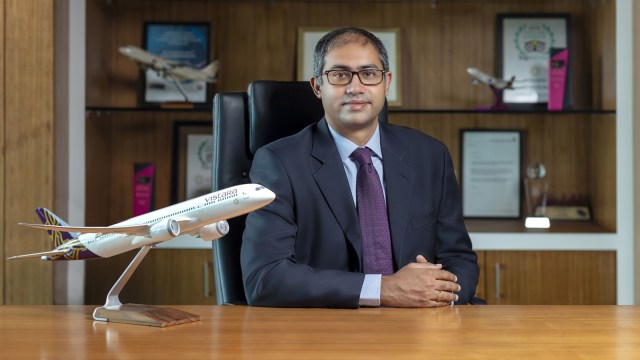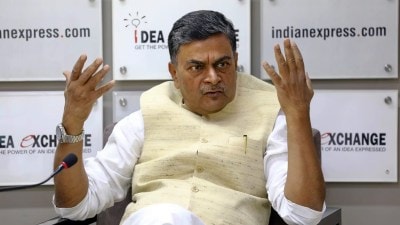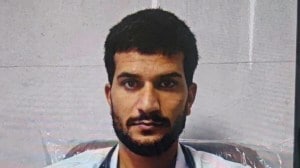According to Vistara’s Chief Executive Officer VINOD KANNAN, while the brand Vistara may slip into the past, its legacy will live on in the new Air India. In an interaction with SUKALP SHARMA, Kannan talks about various facets of the impending merger, including people integration, and how Vistara’s expertise would be critical in making Air India a world-class airline. Edited excerpts:

Q. You have built a formidable and respected brand in Indian aviation. It is going to integrate with a much bigger and older brand (Air India), which has so far not been celebrated for service excellence. How do you see the merger shaping the new Air India brand?
Story continues below this ad
In the aviation business, you need scale, and if you look at the Air India order book, it gives us a chance to expand and grow pretty fast. That is the rationale and it makes perfect sense.
Yes, we (Vistara) have managed to have a good standing in the Indian consumer space. If you look at it objectively, as you mentioned, Air India has so far not come to that level of excellence. But the good thing is that now we have competition approvals, our people can discuss and share knowledge and experience. And the intention and plan is to bring Air India up to the same levels as Vistara. I would say that the expertise at Vistara is crucial for that to happen, because we’ve actually burnt our fingers, we’ve learnt things the hard way, and it’s only fair that we transfer that knowledge since the shareholders are the same.
Yes, that’s the process, it could be a bit tough in the short to medium term because any integration is complicated. But the shareholders (Tata and Singapore Airlines), myself, Campbell (Air India CEO Campbell Wilson), are all on the same page that Air India should, and will get to that level, if not better.
Q. What is the current status of the integration and merger between Vistara and Air India?
Story continues below this ad
The first set of approvals is competition-related and the CCI (Competition Commission of India) has already approved the merger, and so have most other jurisdictions. We have a few pending, Singapore being one of them. I think that is the last one pending, which we hope to get latest by March. The next one is NCLT (National Company Law Tribunal), which is the official merger approval from the Ministry of Corporate Affairs, and that process is also ongoing. We are confident that that should also come through by the first quarter or the first half of this year. The last one is the DPIIT (Department for Promotion of Industry and Internal Trade) approval. We expect all the approvals to come by the middle of this year. Once all these legal approvals are in, the operational merger will start. If all goes right, and subject to further approvals from the ministry (of civil aviation) and DGCA (Directorate General of Civil Aviation), we expect things to take another 12 months or so. So roughly, the timeline for the merger is 2025.
Q. Air India is an older brand that has a strong recall value globally, while Vistara is seen as the better brand in India. Would it not be better to have all international operations under the Air India brand and domestic under Vistara, instead of merging the brands as well?
If you have separate AOCs (Air Operator Certificates) or separate airline registrations, you have to have separate machinery—post holders, specific safety and operational apparatus, etc. It is a lot more efficient if you combine these together instead of having two airlines. Also, one brand makes it a lot more seamless for the customer, particularly on the domestic-to-international connections. So, those are some of the considerations. In the grand scheme of things, with India growing so fast, you will have a lot of feed into the international segment from domestic. So, it makes even more sense to have a single entity.
Q. Mergers can be quite messy when it comes to people integration. How is the morale among Vistara employees about what the future holds? Are there concerns and anxieties around possible staff restructuring and their roles in the merged entity?
Story continues below this ad
The communication from me, Campbell, as well as the board and the shareholders has always been that this is a merger for growth. We are not merging to cut costs. In fact, if anything, the costs are going to go up 3X because the number of aircraft are going to go up that much. So, there is not going to be a dearth of opportunities in the bigger scheme of things. We hope that that message goes through.
Q. Have you started the process of charting out growth paths for your crew in view of the integration, considering there will be more opportunities to transition to wide-body aircraft in the merged airline?
Wherever it’s possible legally and from a compliance perspective, those things have happened. We’ve had town halls with pilots to tell them what is the progress path as everyone wants to ultimately fly on the wide-body aircraft. If you look at the world today, there are not many airlines that give you this opportunity. We have a mix of wide and narrow-body aircraft, and everyone gets a chance, subject to requirement and skill, to move to the wide-body fleet. The principles have been charted out and I think the process and the operational transfer of the pilots will start once we have the approvals.
Q. Despite the integration with Air India under works, Vistara has not slowed down in terms of flight launches and taking aircraft deliveries. Could you talk us through the strategy?
Story continues below this ad
AS I mentioned earlier, the shareholders are the same and the aircraft are here, so you need to deploy them. You cannot keep them on ground. And there is demand, especially for international travel. In fact, around 35 per cent of our capacity is deployed for international flights and that is what we are focusing on. That process will continue. We have three more aircraft that are to be delivered by March or April of 2024, taking the Vistara fleet to 70 aircraft.
The credit goes to my team, because despite all the so-called anxieties, thankfully, they have not let the ball down. They have not let any of us down.
Q. The government has come out with new FDTL (flight duty time limitations) guidelines that are slated to take effect from June 1. How many additional pilots would be required to meet the new norms without affecting the network? Do you foresee capacity cuts?
The rough calculation across the industry is that, as an industry, we need 15 to 20 per cent more pilots, assuming you want to maintain the same network. It could be a scenario where, if you need to comply with these rules by June 1 with the same number of pilots, you will have to shrink your network. For us (Vistara), the impact may be slightly lesser because we are not a low-cost carrier, so we don’t operate so many flights in the midnight hours. But having said that, given the current mandate of compliance by June 1, it basically means that you will have to cut back on capacity. So, there might be aircraft sitting on the ground, or it basically means you have to ramp up the pilot situation, which is something we are all working towards.
Story continues below this ad
The usual lead time (for getting newly-hired pilots ready to operate flights) is about six months. The process (of onboarding more pilots), in fact, had started before (the new FDTL norms were announced). So, we will have to see to what extent we are successful.
Q. Any clarity yet on what your role might be in the merged airline? Or are you looking to go back to Singapore Airlines?
I will let you know when I know. I serve at the mercy of the shareholders. It all depends on what Campbell wants in the new entity and what my employer, which is Singapore Airlines, wants. We will see what happens.

































